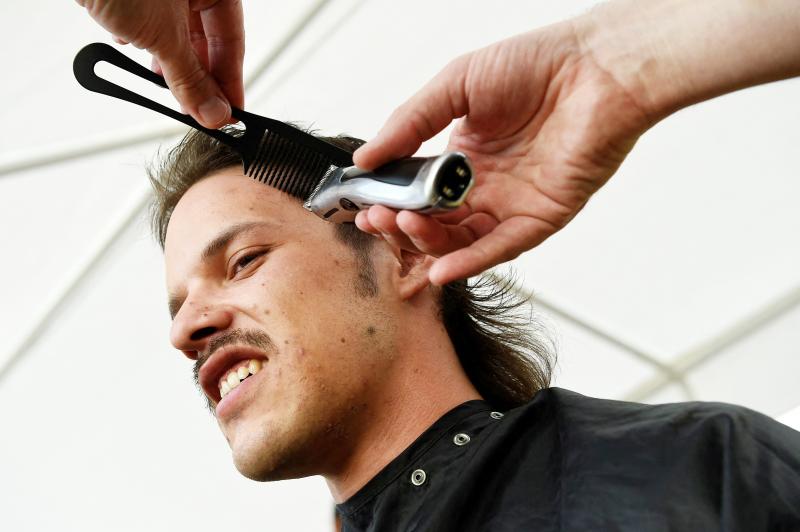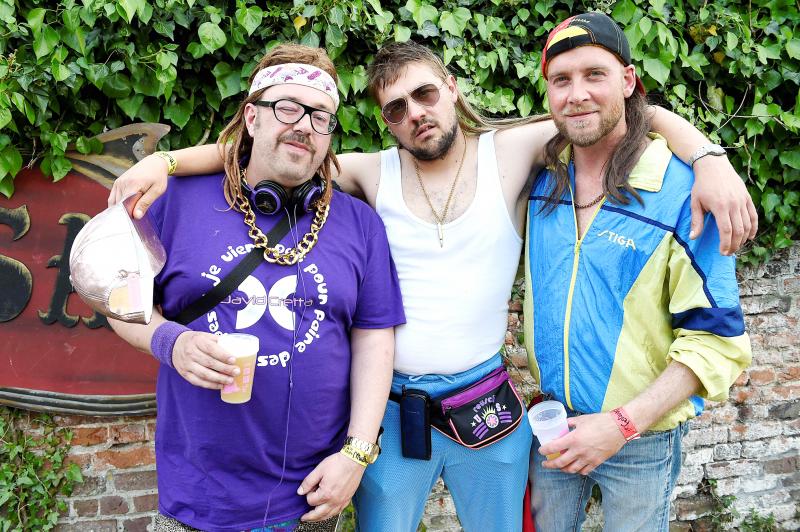“Business in front, party in the back:” a hairstyle considered so obnoxious that for years it verged on being an arrestable offense, the mullet has made the unlikeliest comeback of the century.
From pop stars like Rihanna and Miley Cyrus to a surprisingly high proportion of the England rugby team, the short-front-long-back style has reinvaded the world’s TV screens and high streets.
“My idols have always been David Bowie and Princess Diana, so the initial idea was to look like their lovechild,” said Sharon Daniels, 26, an Australian living in Brighton, England.

Photo: AFP
“Shaz” was well ahead of the game, and when she first arrived in Brighton two years ago, only one other person around town was sporting her do. She knew because people kept sending her pictures of him. Now, the mullet is everywhere. “I don’t necessarily appreciate that, since now it looks like I’m trying to fit in,” Daniels laughed. “I don’t mind. I know how long I’ve been rocking it.”
TOTALLY OWN IT
Fashion cycles are as inevitable as the turning of the planets, but this is one style that many thought buried for good.

Photo: AFP
“It’s back from the dead,” said Tony Copeland of the British Master Barbers Alliance, theorizing that a few months of lockdown growth helped propel the resurrection. “We’re going to see more and more this year. Guys are just fed up with all the skin fades.”
That could mean fierce competition at the next Festival de la Coupe Mulet, Europe’s biggest mullet festival, last held in Belgium in 2019.
Current titleholder Gauthier Istin, a farmer from Brittany in northern France, isn’t worried about defending his crown. For him, the mullet is a passport to good times, and he intends to travel by foot to the next festival in central France in June, like a sort of slower, hairier Forrest Gump.
“I hope people will walk with me along the way, ideally with a mullet but no problem if not,” he said. He takes a philosophical view of his flowing locks: “It’s about having enough confidence in yourself to not take yourself too seriously, and to totally own your look.”
SKULLET, ANYONE?
Istin also points out that the mullet dates back much further than the shoulder pads and rolled-up jacket sleeves of the 1980s.
“If you look at ancient frescoes, Roman mosaics, you’ll see people with them because they’re much simpler than other styles,” he said. Indeed, the History Channel says mullets made their first appearance in literature in Homer’s The Iliad, in which a group of spearmen are described as having “their forelocks cropped, hair grown long at the backs.”
It also credits Benjamin Franklin’s “skullet” (bald on top, long at the back) with helping to charm the French into supporting the nascent United States of America when he was ambassador in the 18th century. His daring, wigless hairstyle was part of a successful PR effort depicting him as a man of “simplicity and innocence.” Amazingly, however, the mullet went for millennia without its own name. It was not christened until 1994, and by an unlikely source.
“You’re coming off like you’re Van Damme, You’ve got Kenny G in your Trans Am,” the Beastie Boys rapped on their 1994 single Mullethead — the first recorded use of the word according to the Oxford English Dictionary.
OFFENSIVE
By that point, the mullet was well on its way to disrepute, moving out of magazine pages and into the truck stops of deep south America, often to be seen near an angry dog on a chain.
“It really became offensive in the nineties,” said Deirdre Novella, of Badlands salon in Brooklyn. “It was for people stuck out in the woods with no idea what was happening.”
Its survival in these outposts may have been as much about practicalities as aesthetics, saving necks from getting red and requiring minimal maintenance. “It’s true that I don’t get sunburnt, and I don’t need to tie my hair up when I’m using a circular saw,” said Daniels.
These are not the driving concerns for most mullet-requesters at Novella’s Brooklyn salon, who tend to be LGBT or “hardcore art” scenesters.
“You have to have some really radical style: the sort of people who wear clothes that don’t look good, but they’re so fashionable they can pull it off,” she said.
Still, the mullet has always looked tough, and that won’t change even after a million Brooklyn and Shoreditch hipsters insta their two-tier cuts to ironic death. “I once found myself on a ferry to Tasmania with the Outlaws motorbike gang and the percentage of mullets was insane,” said Daniels. “It’s just a badass hairstyle.”

May 26 to June 1 When the Qing Dynasty first took control over many parts of Taiwan in 1684, it roughly continued the Kingdom of Tungning’s administrative borders (see below), setting up one prefecture and three counties. The actual area of control covered today’s Chiayi, Tainan and Kaohsiung. The administrative center was in Taiwan Prefecture, in today’s Tainan. But as Han settlement expanded and due to rebellions and other international incidents, the administrative units became more complex. By the time Taiwan became a province of the Qing in 1887, there were three prefectures, eleven counties, three subprefectures and one directly-administered prefecture, with

President William Lai (賴清德) yesterday delivered an address marking the first anniversary of his presidency. In the speech, Lai affirmed Taiwan’s global role in technology, trade and security. He announced economic and national security initiatives, and emphasized democratic values and cross-party cooperation. The following is the full text of his speech: Yesterday, outside of Beida Elementary School in New Taipei City’s Sanxia District (三峽), there was a major traffic accident that, sadly, claimed several lives and resulted in multiple injuries. The Executive Yuan immediately formed a task force, and last night I personally visited the victims in hospital. Central government agencies and the

Among Thailand’s Chinese Nationalist Party (KMT) villages, a certain rivalry exists between Arunothai, the largest of these villages, and Mae Salong, which is currently the most prosperous. Historically, the rivalry stems from a split in KMT military factions in the early 1960s, which divided command and opium territories after Chiang Kai-shek (蔣介石) cut off open support in 1961 due to international pressure (see part two, “The KMT opium lords of the Golden Triangle,” on May 20). But today this rivalry manifests as a different kind of split, with Arunothai leading a pro-China faction and Mae Salong staunchly aligned to Taiwan.

As with most of northern Thailand’s Chinese Nationalist Party (KMT) settlements, the village of Arunothai was only given a Thai name once the Thai government began in the 1970s to assert control over the border region and initiate a decades-long process of political integration. The village’s original name, bestowed by its Yunnanese founders when they first settled the valley in the late 1960s, was a Chinese name, Dagudi (大谷地), which literally translates as “a place for threshing rice.” At that time, these village founders did not know how permanent their settlement would be. Most of Arunothai’s first generation were soldiers